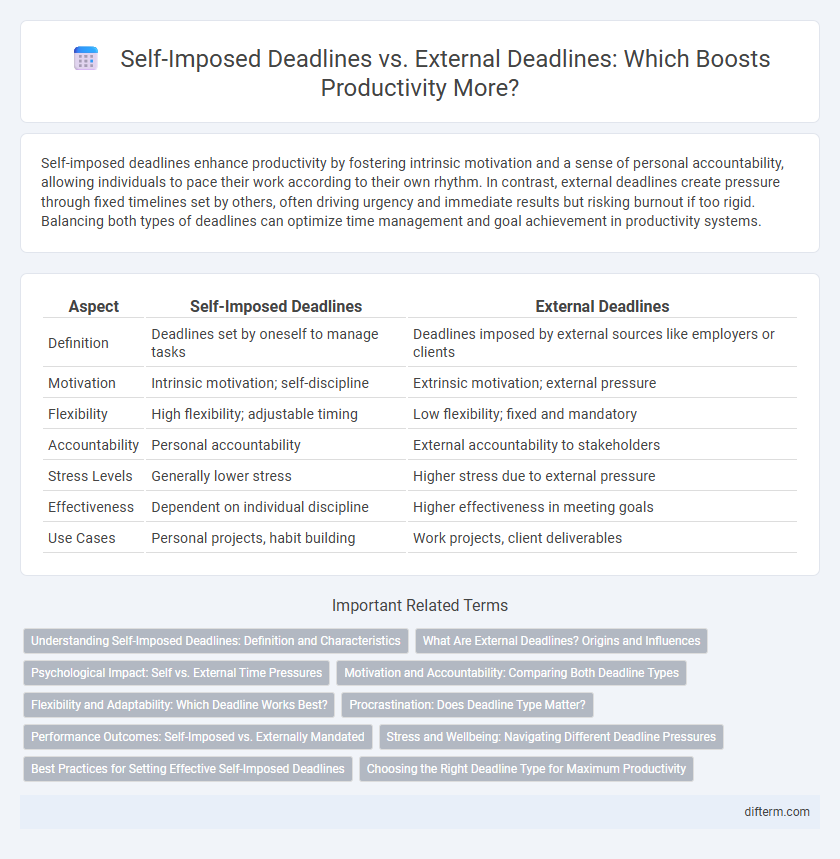Self-imposed deadlines enhance productivity by fostering intrinsic motivation and a sense of personal accountability, allowing individuals to pace their work according to their own rhythm. In contrast, external deadlines create pressure through fixed timelines set by others, often driving urgency and immediate results but risking burnout if too rigid. Balancing both types of deadlines can optimize time management and goal achievement in productivity systems.
Table of Comparison
| Aspect | Self-Imposed Deadlines | External Deadlines |
|---|---|---|
| Definition | Deadlines set by oneself to manage tasks | Deadlines imposed by external sources like employers or clients |
| Motivation | Intrinsic motivation; self-discipline | Extrinsic motivation; external pressure |
| Flexibility | High flexibility; adjustable timing | Low flexibility; fixed and mandatory |
| Accountability | Personal accountability | External accountability to stakeholders |
| Stress Levels | Generally lower stress | Higher stress due to external pressure |
| Effectiveness | Dependent on individual discipline | Higher effectiveness in meeting goals |
| Use Cases | Personal projects, habit building | Work projects, client deliverables |
Understanding Self-Imposed Deadlines: Definition and Characteristics
Self-imposed deadlines are personally set timeframes that drive individuals to complete tasks without external pressure, enhancing intrinsic motivation and accountability. These deadlines often reflect personal goals and priorities, fostering better time management and focus by aligning tasks with individual productivity rhythms. Understanding the characteristics of self-imposed deadlines, such as flexibility and self-discipline, is crucial for effectively leveraging them to boost overall work efficiency and goal achievement.
What Are External Deadlines? Origins and Influences
External deadlines are time constraints set by outside authorities such as employers, clients, or regulatory bodies that dictate when tasks or projects must be completed. These deadlines often originate from organizational goals, contractual obligations, or industry standards, exerting pressure that influences prioritization and workflow efficiency. Their impact on productivity stems from creating a structured environment that fosters accountability and timely task execution.
Psychological Impact: Self vs. External Time Pressures
Self-imposed deadlines often foster intrinsic motivation and personal accountability, enhancing focus through controlled time management. External deadlines can induce higher stress levels due to perceived pressure and fear of negative consequences, which may impair cognitive function and decision-making. Balancing self-imposed and external time pressures optimizes productivity by leveraging internal drive while maintaining necessary external accountability.
Motivation and Accountability: Comparing Both Deadline Types
Self-imposed deadlines enhance intrinsic motivation by fostering personal accountability and a sense of ownership over tasks, leading to higher engagement and self-discipline. External deadlines drive extrinsic motivation through imposed accountability, often increasing urgency and focus due to external expectations and consequences. Comparing both, a balanced approach leveraging the self-regulation of internal deadlines and the pressure of external deadlines maximizes productivity and sustained motivation.
Flexibility and Adaptability: Which Deadline Works Best?
Self-imposed deadlines offer greater flexibility, allowing individuals to adjust timelines based on progress and unforeseen challenges, which enhances adaptability in dynamic work environments. External deadlines create structured accountability that can boost motivation but may reduce the ability to pivot when priorities shift rapidly. Balancing both deadline types optimizes productivity by combining personal flexibility with external pressure to meet critical milestones efficiently.
Procrastination: Does Deadline Type Matter?
Self-imposed deadlines often lead to increased procrastination compared to external deadlines due to lower perceived pressure and accountability. External deadlines create a sense of urgency and enforce time constraints through consequences or expectations from others, which can significantly reduce procrastination. Research shows that the structure imposed by external deadlines enhances focus and task completion rates, while self-imposed deadlines require stronger intrinsic motivation to be effective.
Performance Outcomes: Self-Imposed vs. Externally Mandated
Self-imposed deadlines often enhance intrinsic motivation, leading to higher-quality work and improved time management compared to externally mandated deadlines. Performance outcomes under self-imposed deadlines tend to show increased creativity and sustained focus, whereas external deadlines can boost urgency but may also induce stress and reduce overall work satisfaction. Research indicates that blending both types of deadlines strategically can optimize productivity by balancing autonomy with external accountability.
Stress and Wellbeing: Navigating Different Deadline Pressures
Self-imposed deadlines often foster intrinsic motivation and a sense of control, reducing stress and enhancing wellbeing compared to external deadlines that can trigger anxiety due to imposed expectations and time constraints. Research from the American Psychological Association highlights that external deadlines increase cortisol levels, negatively impacting mental health, whereas self-imposed deadlines align with personal pacing and goal-setting, promoting sustainable productivity. Balancing these deadline types by integrating flexible self-imposed targets within externally mandated frameworks can optimize stress management and overall wellbeing in high-pressure environments.
Best Practices for Setting Effective Self-Imposed Deadlines
Setting effective self-imposed deadlines involves creating specific, measurable, and time-bound goals that mimic the urgency of external deadlines. Utilizing techniques like time blocking and prioritization enhances focus and accountability, while regularly reviewing progress helps adjust timelines to maintain motivation and prevent procrastination. Clear consequences and rewards paired with realistic scheduling ensure self-discipline and sustained productivity.
Choosing the Right Deadline Type for Maximum Productivity
Self-imposed deadlines enhance productivity by fostering intrinsic motivation and personal accountability, while external deadlines provide structure and clear time constraints that reduce procrastination. Choosing the right deadline type depends on individual work habits and task complexity, with a hybrid approach often yielding optimal results for sustained focus and task completion. Leveraging psychological factors like time pressure and self-regulation improves overall effectiveness in managing productivity.
Self-Imposed Deadlines vs External Deadlines Infographic

 difterm.com
difterm.com